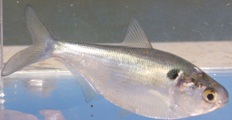AUTHORS
Michael J. Vanni1, 2 and Jessica A. Gephart1
1 - Department of Zoology, Miami University, Oxford, Ohio 45056
2 - Corresponding Author: Michael Vanni (vannimj@muohio.edu)
THE ECOLOGICAL QUESTION
Do nutrient cycling (excretion) rates of fish in lakes scale with body size and temperature as predicted by The Metabolic Theory of Ecology?
ECOLOGICAL CONTENT
Animal metabolism, allometry, temperature dependence, nutrient cycling
WHAT STUDENTS DO
Students use data on the nitrogen and phosphorus excretion rates of fish to test hypotheses related to metabolic ecology. Specifically, we examine predictions related to allometry and temperature dependences by asking how excretion rates are related to fish body size and temperature. The data are derived from fish in intact ecosystems (lakes), not from lab experiments. Therefore, the data can be used to ask how well predictions of metabolic ecology are borne out under field conditions.
SKILLS
Using a spreadsheet to make graphs and do basic statistical analyses; working with a “large” data set; quantifying the simultaneous effects of two independent variables; working in groups; making presentations; evaluating the support for various hypotheses
STUDENT-ACTIVE APPROACHES
Cooperative learning, group work assessment, guided inquiry
ASSESSABLE OUTCOMES
Graphs depicting patterns; estimates of slopes using simple linear regression; creativity in analyzing data; critical thinking; drawing conclusions about the validity of hypotheses
SOURCE
Data are derived from these two papers:
Higgins, KA, MJ Vanni, and MJ González. 2006. Detritivory and the stoichiometry of nutrient cycling by a dominant fish species in lakes of varying productivity. Oikos 114:419-430.
Schaus, M.H., M.J. Vanni, T.E. Wissing, M.T. Bremigan, J.E. Garvey and R.A. Stein. 1997. Nitrogen and phosphorus excretion by detritivorous gizzard shad in a reservoir ecosystem. Limnology and Oceanography 42:1386-1397.
DOWNLOADS
- Full Article Text [doc], [pdf]
- Fish nutrient excretion (Faculty) [xls]
- Fish nutrient excretion (Students) [xls]
- Fish nutrient excretion rubric [doc]
- Fish nutrient excretion peer evaluation [doc]
- Fish nutrient excretion student assessment [doc]
- Gizzard shad [jpg]
- Acton Lake aerial view [jpg]
- Animal nutrient budget [tif]
- Lake nutrient cycling diagram [tif]
- Allometry graphs [tif]
Data sets
Assessment forms
Images
ACKNOWLEDGMENTS
Thanks to Maynard Schaus and Karen Higgins; their research as graduate students generated these data. Their research was supported by grants from the National Science Foundation (NSF) and Miami University. Preparation of this exercise was supported by NSF LTREB (DEB 0743192) and OPUS (DEB 0918993) grants to MJV. Special thanks to the students in the honors section of the general ecology course at Miami University (Botany/Zoology 209H) for participating in trial versions of this exercise.
CITATION
Michael J. Vanni and Jessica A. Gephart. March 2011, posting date. Metabolic ecology: How do body size and temperature affect nutrient cycling rates?Teaching Issues and Experiments in Ecology, Vol. 7: Practice #2 [online]. http://tiee.esa.org/vol/v7/issues/data_sets/vanni/abstract.html
